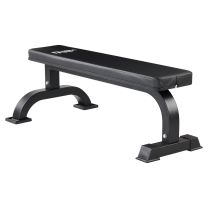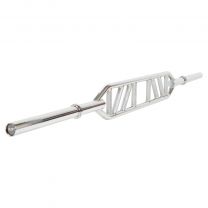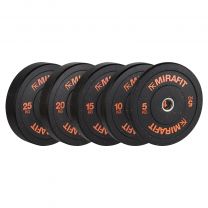5 Strategies For A Bigger Bench Press
5 Strategies For A Bigger Bench Press

The chest is one of the easiest areas to work. Ask anyone in the gym how to target their pecs and they’ll be able to reel off a complete list of pushes, presses, raises and flyes.
But what if you know all the exercises and you’re still not getting anywhere?
When targeting is second nature but increasing overall volume is still out of reach, then it’s time to look at what’s going on.
And it’s more than likely that there will be several things you can do to start upping your stats.
Before we get into some of the key strategies for building a sizeable chest however, it’s worth noting a few basic premises:
- Make sure you’re eating right – if you’re dieting, not getting enough calories or not getting the right nutrition, it’s unlikely that you’ll build any muscle. Training and proper diet go hand-in-hand so if you’re lifting to tear muscle but not repairing it properly with the right foods, you’re setting yourself up for failure.
- Address any injuries – joints take a long time to heal and if you’re trying to lift heavy with an old shoulder or wrist injury, then you’re on shaky ground – literally. Always make sure you are in good health to start your road to progression.
- Give your training the time it deserves – doing the odd session here and there isn’t exactly great for building consistency. You need to be disciplined and make a note of all your lifts each week.
- Be open to starting again – sometimes you can have a poor technique but still progress – to a certain point. But it might be that the guy who taught you how to bench when you were 16, wasn’t actually that great. And even though you’ve got so far, you might need to take a step back and start again.
- Make sure your equipment is up to scratch – you can’t get set up properly unless you have the right training equipment. Our M3 Powerlifting Bench can also handle up to 500kg so it’s ideal for experienced lifters as well as beginners.
So, if you’ve got these covered and you’re ready to get started, let’s look at how you can start increasing your bench press.
How to increase your bench press
Here are some of the best ways to make sure you’re benching as much as possible. That way, you can set yourself up to build both strength and size.
1 - Use a range of weight bars

Although a straight 7ft barbell is the standard way to bench, there are other types of weight bar that will help you get more out of your benching.
For example, using an Swiss Barbell is ideal for anyone who has joint mobility issues. The bar forces you to maintain a neutral grip as well as keep your shoulders tucked in. This is harder to do but is one of the ultimate ways to start building strength as well as reduce shoulder strain.
Dumbbells are also good to bench with. Can you lift as much weight using them? Probably not. However, the movement is more complex so they can be tricky to do. In addition, you can’t rack them so it’s more difficult to get into position. They also allow you to keep a check on any imbalances you might have going on. So, a really good way to avoid asymmetries while training.
2 - Mix up your training

We all know that consistent, progressive overload is key for building strength. However, it’s also important to vary your training styles while continuing with the same types of exercises.
By training explosively, you’ll be lifting slightly lighter weight loads. However, you will be able to work towards getting past your sticking point. So, if this is an issue for you, make sure you are including some in your workouts.
Accessory lifts are also vital for helping you develop complete strength. Use Olympic Barbell Weighted Chains to help develop control.
And if you’re currently focusing your benching, then you might want to start getting in a variety of set types. These will include:
- Drop sets (dropping the weight but maintaining the number of reps)
- Supersets (little to no rest in-between exercises)
- Pyramid sets (going from high reps to low reps with little to no rest in-between)
3 - Focus your technique

To lift heavy, you need to make sure your form is on point. This includes:
• Follow a correct bar path – at the highest point, the barbell should be directly above your eyeline. You then need to bring the bar down towards the bottom of your chest. So, essentially, the bar path is slightly diagonal.
• Elbows and shoulders should be tucked in – when bench pressing, you need to make sure you don’t have your elbows right out. Flared elbows and unstable shoulders are a recipe for injury.
• Breathe properly – a lot of people forget how important breathing is when you lift. As you unrack the bar, you need to take a deep breath. Breathe out and then take another deep breath and brace your abs before you lower the bar. Once the bar is in its lowest position, breathe back out again as you push back up. Doing this will help you stay tight as well as take more weight.
• Drive through your feet – when benching, you need to be able to drive through your feet. This doesn’t necessarily mean having your feet flat on the floor, but it does mean that they need to be locked in position as you bench press.
• Back arch – having an arched back isn’t just a powerlifting technique – it should apply whenever you bench press. Doing this shortens the bar path, keeps your back tight (to reduce your risk of injury) and also encourages you to keep your glutes firmly pressed into the bench. It also stretches out your pecs helping you to maximise your gains.
• Squeeze your shoulders – keeping your shoulders squeezed together is fundamental for a safe and optimal bench press. So, do this not just as you unrack the bar, but throughout the exercise.
• Don’t let your hips come off the bench – as mentioned above, you need to make sure your glutes don’t come off the bench. You’ll lose all that tightness if you do and put yourself at risk of injury. You should be driving through your shoulders, glutes and feet throughout the exercise.
• Forearms and wrists should be straight – to be able to create the maximum amount of force, you need to make sure your wrists and forearms are in a straight line. A good pair of wrist straps will help you do this as they’ll help to prevent your wrists from bending.
• Your knees should be lower than your hips – this one depends a little on body type but in general, your knees should be lower than your hips. You might need to take a wide stance on the bench to be able to achieve this.
4 - Bench first

If you’re focusing your benching, it’s really important that you make it your first lift of your training session on chest day. By doing this, you can devote all your energy to improving your bench press.
It’s worth noting a couple of other beneficial habits that will help you progress here too.
As well as making sure bench pressing is your priority, it’s also important you properly prepare for your training sessions. This means eating well and getting enough rest.
Stress can impact your workouts, so pay attention to your body and how you’re feeling. And, if necessary, adjust your training routine accordingly to make sure you get the most out of your time on the bench.
Pay attention to any injuries you might have going on and make sure they’re addressed before you continue with your training.
Finally, don’t try and lift your one-rep max without warming up properly first. You’re not aiming to pick up from where you left off as soon as you hit the gym.
Work your way up to your heavier lifts progressively.
5 - Don’t just rely on benching

When you bench with proper form, you target several muscle groups including your chest, triceps, shoulders and even your back. Benching alone however, isn’t going to help you isolate and address any weak links in the chain.
So, you need to make sure you’re building maximal strength across your upper body and not just in your pecs.
Dumbbell pressing variations in particular will help you keep everything balanced as well as give you the opportunity to press at various different angles so you can hit each part.
How many days a week should I bench press?

If benching is your focus and you really want to start seeing some progress, then benching twice a week (with rest days in-between) is about the right amount.
It’s also important you make a note of your figures each time so that you can stay on track with your progression.
And with two sessions a week, there will be more opportunities to get in your accessory lifts as well as your supersets and drop sets.
Do push ups increase your bench press?

Firstly, we need to answer another question: what’s a good amount of weight to bench?
If you’re benching your bodyweight, then you’re doing well.
And even though push ups aren’t quite the same as pressing a barbell, you’re still working with (close to) your full bodyweight. Put a weight plate on your back and they’re even better.
Push ups are also compound exercises which will help you develop strength, endurance and control.
As you progress your bench press, you might find that doing push ups regularly on top of your training will really help improve your endurance.
They’re really functional too so make sure you find the time to build them into your routine.
When it comes to building muscle, it’s definitely not one size fits all and different approaches suit different people.
If you’re looking to get started and want to know more about working out with a weight bench, check out six best exercises for strength using a weight bench.
For more content, follow us on Instagram, YouTube, TikTok, and on our official Mirafit Facebook page.
Enter your email to signup to our newsletter
Tags: Equipment > Bars and Weight Plates ; Equipment > Benches ; Exercise Type > Strength







